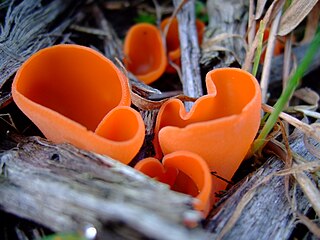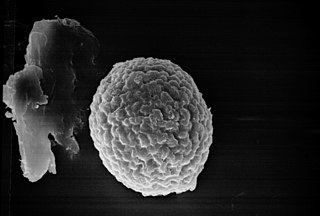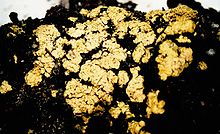
Pezizomycotina make up most of the Ascomycota fungi and include most lichenized fungi too. Pezizomycotina contains the filamentous ascomycetes and is a subdivision of the Ascomycota. It is more or less synonymous with the older taxon Euascomycota. These fungi reproduce by fission rather than budding and this subdivision includes almost all the ascus fungi that have fruiting bodies visible to the naked eye.

Dothideomycetes is the largest and most diverse class of ascomycete fungi. It comprises 11 orders 90 families, 1300 genera and over 19,000 known species. Traditionally, most of its members were included in the loculoascomycetes, which is not part of the currently accepted classification. This indicates that several traditional morphological features in the class are not unique and DNA sequence comparisons are important to define the class.

Pezizomycetes are a class of fungi within the division Ascomycota.

Phaeosphaeria nodorum is a major fungal pathogen of wheat, causing the disease Septoria nodorum blotch, and a member of the Dothideomycetes, a large fungal taxon that includes many important plant pathogens affecting all major crop plant families.

Cochliobolus lunatus is a fungal plant pathogen that can cause disease in humans and other animals. The anamorph of this fungus is known as Curvularia lunata, while Cochliobolus lunatus denotes the teleomorph or sexual state. They are, however, the same biological entity. Cochliobolus lunatus is the most commonly reported species in clinical cases of reported Cochliobolus infection.

The Gomphales are an order of basidiomycete fungi. Some or all families belonging to Gomphales have been sometimes included in the order Phallales, the now-obsolete Ramariaceae was also previously included in Cantharellales. Recent phylogenetic analyses include in Gomphales the families of the original description of the order by Walter Jülich, with addition of Clavariadelphaceae. According to one 2008 estimate, the Gomphales contain 18 genera and 336 species.

Stagonospora is a genus of fungi clustering in the Phaeosphaeriaceae (Quaedvlieg). Several of the species in this genus are plant pathogens.

The Pleosporales is the largest order in the fungal class Dothideomycetes. By a 2008 estimate it contains 23 families, 332 genera and more than 4700 species. The majority of species are saprobes on decaying plant material in fresh water, marine, or terrestrial environments, but several species are also associated with living plants as parasites, epiphytes or endophytes. The best studied species cause plant diseases on important agricultural crops e.g. Cochliobolus heterostrophus, causing southern corn leaf blight on maize, Phaeosphaeria nodorum causing glume blotch on wheat and Leptosphaeria maculans causing a stem canker on cabbage crops (Brassica). Some species of Pleosporales occur on animal dung and a small number occur as lichens and rock-inhabiting fungi.

Capnodiales is a diverse order of Dothideomycetes, initially based on the family Capnodiaceae, also known as sooty mold fungi. Sooty molds grow as epiphytes, forming masses of black cells on plant leaves and are often associated with the honeydew secreted by insects feeding on plant sap. This diverse order has been expanded by the addition of several families formerly thought unrelated and now also includes saprobes, endophytes, plant pathogens, lichens and rock-inhabiting fungi. The new additions include the genus Mycosphaerella containing the causal agents of several economically important crop and tree diseases. A small number of these fungi are also able to parasitise humans and animals, including species able to colonise human hair shafts.

Pleosporomycetidae is a subclass of Dothideomycetes consisting of four orders: Pleosporales, Hysteriales, Mytilinidiales, and Jahnulales. One of its defining features is the presence of pseudoparaphyses. These are sterile cells extending down from the upper portion of the cavity inside sexual structures containing the sac-like asci with sexually produced spores (ascospores). Pseudoparaphyses are initially attached at both their ends, but sometimes the upper part may become free. Some orders and families where these cells are present remain outside the subclass since DNA based phylogenies cannot place them with confidence. However they could conceivably be included within Pleosporomycetidae in future.
The Hysteriales are an order of fungi in the class Dothideomycetes, subclass Pleosporomycetidae. It consists of a single family, Hysteriaceae. Members of Hysteriales produce elongated, often boat shaped sexual structures with slit-like openings (hysterothecia). However species with these structures are very diverse. Comparisons based on DNA sequences indicate species with hysterothecia do not share a single ancestor and therefore species with hysterothecia can be found in several fungal orders. The newest definition of the order relies on DNA sequence differences and a combination of morphological characters.
Leotiomyceta represents all the filamentous ascomycete fungi (Pezizomycotina), excluding the classes Pezizomycetes and Orbiliomycetes. It is well supported in several studies comparing DNA sequences in fungi. It has originally been proposed as a superclass but more recently was proposed as a rankless taxon for any well supported group above class. Rankless taxa do not strictly follow the rules for taxonomic classifications in plants and fungi (ICBN) and therefore these names are informal, although they appear to reflect natural groups.

The Entylomatales are an order of smut fungi in the class Exobasidiomycetes. A monotypic order, it consists of a single family, the Entylomataceae. Both the family and order were circumscribed in 1997.
The Georgefischeriales are an order of smut fungi in the class Exobasidiomycetes. The order consists of four families, the Eballistraceae, the Georgefischeriaceae, the Gjaerumiaceae, and the Tilletiariaceae.
The Microstromatales are order of fungi in the class Exobasidiomycetes. The order consists of three families: the Microstromataceae, the Quambalariaceae, and the Volvocisporiaceae.

The Tilletiales are an order of smut fungi in the class Exobasidiomycetes. It is a monotypic order, consisting of a single family, the Tilletiaceae, which contains seven genera. The roughly 150 species in the Tilletiales all infect hosts of the grass family, except for species of Erratomyces, which occur on legumes.
The Davidiellaceae are a family of fungi in the Ascomycota, class Dothideomycetes. The family was defined in 2006 based on the results of molecular phylogenetic analysis of various Dothideomycetes species, and contains the genus Davidiella and six other genera.

Mytilinidiales is an order of fungi within the class Dothideomycetes.

The Gloniaceae are a family of fungi in the order Mytilinidiales.

The Didymellaceae are a family of fungi in the order Pleosporales.












